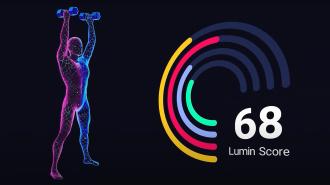A first-of-its-kind smart gym in Texas is using AI trainers, motion-tracking sensors, and “gamified” classes to help people get the most from their workouts — and stay motivated to keep coming back.
The challenge: Exercising regularly is one of the best things you can do for your health — not only can it help you maintain a healthy weight, it can also make you stronger, reduce your risk of disease, and decrease your chances of developing depression and anxiety.
Despite all of those benefits, though, fewer than 30% of American adults — in any region — exercise as much as the CDC recommends. (For most people, the CDC says you should do muscle strengthening on two days a week and the equivalent of about 30 minutes of “brisk walking” five days a week.)
Smart gym: There are a million reasons people don’t exercise. Some lack the motivation needed to maintain the habit. Others are concerned they’ll injure themselves — a personal trainer could keep an eye on their form, but those can be expensive and intimidating.
A new smart gym in Las Colinas, Texas, hopes to help people hit their exercise goals by combining AI trainers with workouts designed to feel more like playing games than trudging through chores.
The walls of the smart gym are lined with screens. After checking into the gym through its smartphone app, you’re assigned one of 14 stations in the studio, which means you stand facing a certain part of the wall.
Your screen can guide you through a solo session, which you can tailor to specific muscle groups or fitness goals. Alternatively, group classes start every 45 minutes, so everyone will be sweating through the same high-intensity workout you are.
Motion-tracking sensors behind the screen will ensure you’re using proper form during the workout, and everything you do during your time at the gym will be tracked in the smartphone app.
“The AI trainer is the one giving form feedback, doing the motivation, and explaining how to do the movements.”
Brandon Bean
To motivate you, the screen will display graphics that “gamify” your workout, letting you earn points that can land you a place on the gym’s leaderboard or be traded in for perks, like trial memberships for friends.
You’ll also be able to choose one of four AI trainers to provide verbal guidance and feedback to you through headphones — one named Emma, for example, will bring “warmth and positivity” to your workout, while Rex’s coaching style focuses more on “discipline and tough love.”
Lumin Fitness does have one real-life fitness professional overseeing the studio at all times, but they aren’t expected to regularly interact with gym goers.
“We liken it to being more like an airline attendant than an actual coach,” Brandon Bean, Lumin Fitness’s co-founder and former CEO of Gold’s Gym, told MIT Technology Review. “You want someone there if something goes wrong, but the AI trainer is the one giving form feedback, doing the motivation, and explaining how to do the movements.”
Looking ahead: Lumin Fitness isn’t cheap — an unlimited membership costs $250 per month, compared to about $50 at the average gym. It is cheaper than paying for the same amount of time with a personal trainer, though, and you wouldn’t have to worry about your AI coach judging you for only being able to power through three burpees during your first session.
Currently, Lumin Fitness just has one location, so if you don’t live near Las Colinas, you’re going to need to find some other way to motivate yourself to exercise. It is looking for people to franchise the model, though, so it’s possible a smart gym could open near you in the near future.
We’d love to hear from you! If you have a comment about this article or if you have a tip for a future Freethink story, please email us at tips@freethink.com.
